Direct Immunofluorescence – Friday Pop Quiz – 8/20/21
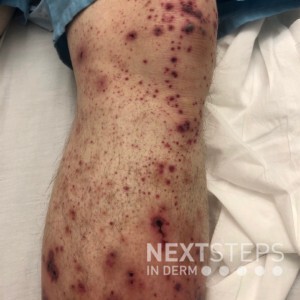 Similar lesions are present on the contralateral leg, and this patient also reports joint pain and tarry stools. A biopsy for direct immunofluorescence is most likely to show which of the following?
A. IgA deposition in the dermal papillae
B. Perivascular IgA deposition
C. Perivascular IgG deposition
D. Linear IgA deposition along the basement membrane zone
E. Linear IgG deposit …
Similar lesions are present on the contralateral leg, and this patient also reports joint pain and tarry stools. A biopsy for direct immunofluorescence is most likely to show which of the following?
A. IgA deposition in the dermal papillae
B. Perivascular IgA deposition
C. Perivascular IgG deposition
D. Linear IgA deposition along the basement membrane zone
E. Linear IgG deposit …
 Similar lesions are present on the contralateral leg, and this patient also reports joint pain and tarry stools. A biopsy for direct immunofluorescence is most likely to show which of the following?
A. IgA deposition in the dermal papillae
B. Perivascular IgA deposition
C. Perivascular IgG deposition
D. Linear IgA deposition along the basement membrane zone
E. Linear IgG deposit …
Similar lesions are present on the contralateral leg, and this patient also reports joint pain and tarry stools. A biopsy for direct immunofluorescence is most likely to show which of the following?
A. IgA deposition in the dermal papillae
B. Perivascular IgA deposition
C. Perivascular IgG deposition
D. Linear IgA deposition along the basement membrane zone
E. Linear IgG deposit … Continue reading "Direct Immunofluorescence – Friday Pop Quiz – 8/20/21"


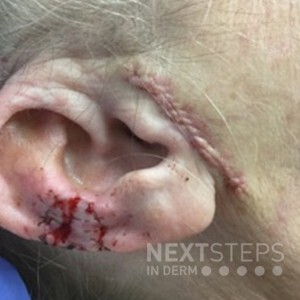 This patient underwent Mohs surgery and presents for suture removal. The following photo is an example of which type of closure?
A. Split-thickness skin graft
B. Full-thickness skin graft
C. Composite graft
D. Transposition flap
E. Interpolation flap
To find out the correct answer and read the explanation, click here.
Brought to you by our brand partner Derm In-Rev …
This patient underwent Mohs surgery and presents for suture removal. The following photo is an example of which type of closure?
A. Split-thickness skin graft
B. Full-thickness skin graft
C. Composite graft
D. Transposition flap
E. Interpolation flap
To find out the correct answer and read the explanation, click here.
Brought to you by our brand partner Derm In-Rev … 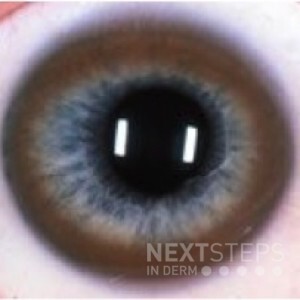 A 20-year-old male presents with jaundice, hepatomegaly, blue lunulae, and the ocular finding as shown. What is the genetic mutation in this condition?
A. Phenylalanine hydroxylase (PAH) gene
B. α-galactosidase A (GLA) gene
C. ATP7B gene
D. Glucocerebrosidase (GBA) gene
E. Cystathionine β-synthase (CBS) gene
To find out the correct answer and read the explanation, click here. …
A 20-year-old male presents with jaundice, hepatomegaly, blue lunulae, and the ocular finding as shown. What is the genetic mutation in this condition?
A. Phenylalanine hydroxylase (PAH) gene
B. α-galactosidase A (GLA) gene
C. ATP7B gene
D. Glucocerebrosidase (GBA) gene
E. Cystathionine β-synthase (CBS) gene
To find out the correct answer and read the explanation, click here. … 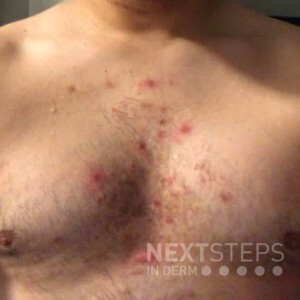 A 28-year-old male presents with follicular pustules on the upper trunk and mid-chest. Many of the lesions are arising on an erythematous base. On exam, you notice the eruption favors areas with terminal hairs and is also present on the scalp and beard, buttocks and lower extremities. You suspect he may have superficial folliculitis. What is the most common cause of this condition which would …
A 28-year-old male presents with follicular pustules on the upper trunk and mid-chest. Many of the lesions are arising on an erythematous base. On exam, you notice the eruption favors areas with terminal hairs and is also present on the scalp and beard, buttocks and lower extremities. You suspect he may have superficial folliculitis. What is the most common cause of this condition which would … 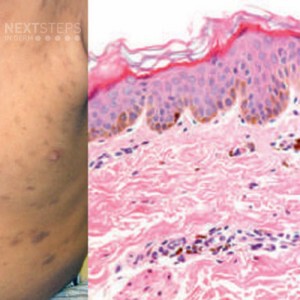 What is the most likely diagnosis in an otherwise well appearing 3-year-old child with a spontaneous eruption of the rash seen below?
A. Pityriasis rosea
B. Erythema dyschromicum perstans
C. Café-au-lait macules
D. Pigmentary mosaicism
E. None of the above
To find out the correct answer and read the explanation, click here.
Brought to you by our brand partner Derm In-Review …
What is the most likely diagnosis in an otherwise well appearing 3-year-old child with a spontaneous eruption of the rash seen below?
A. Pityriasis rosea
B. Erythema dyschromicum perstans
C. Café-au-lait macules
D. Pigmentary mosaicism
E. None of the above
To find out the correct answer and read the explanation, click here.
Brought to you by our brand partner Derm In-Review …